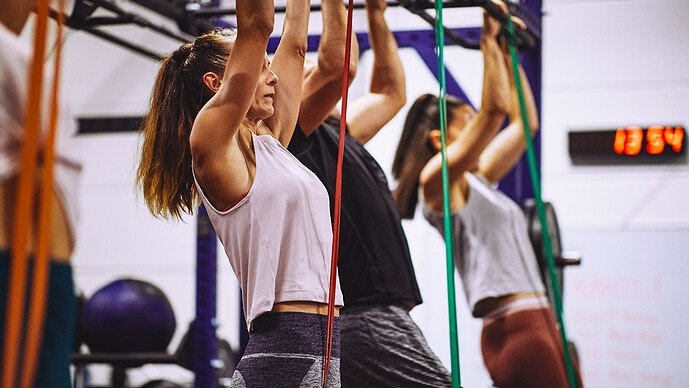The Pull-Up is Overrated. Get Stronger Anyway
Pull-ups actually aren’t a great measure of strength. But if you want to get better at them anyway, try these proven strategies.
Strong People Can Still Suck At Pull-Ups
Many believe that if you’re strong, you should be able to do a ton of pull-ups with added weight. But that’s not quite accurate. In a recent video, pro strongman Brian Shaw struggles to get four bodyweight pull-ups, and he only gets his chin over the bar in the first two.
This should tell you that pull-up performance isn’t a realistic measure of strength for everyone because it involves other variables, like body weight and body type. If you think you “ought” to be awesome at pull-ups, then you’ve got a false perception of your progress and current strength level.
Here’s why, plus how to get stronger on pull-ups anyway if that’s your goal.
Is Doing More Pull-Ups Even a Good Goal?
Is Doing More Pull-Ups Even a Good Goal?
For some, sure. But one of my male clients, who’s making tremendous progress in all areas of strength and fitness, still can’t do a pull-up. And it’s not just him. This is something I’ve heard from figure girls, too. These are often people I train who, despite their amazing gains in just about every other metric of fitness, are frustrated with their pull-up numbers.
Sure, improving pull-up performance is a respectable goal, but it’s not a realistic one for many. And if you’re in the same boat, fixating on this single exercise will set you up for failure.
First, having long arms is less conducive to being good at pull-ups. You not only have to cover more distance (than someone with shorter arms) to get your chin above the bar, but you’ve also got less of a mechanical advantage over your bodyweight.
Second, research shows that the ability to perform pull-ups is heavily influenced by body composition (1,2) and may not be a good indicator of absolute vertical pulling strength (3). This explains why people with a thicker and stronger lower body often struggle with pull-ups.
Just look at some heavyweight powerlifters who have impressive lifting numbers but couldn’t do a chin-up if they got free PEDs for life. Yet you can find rock climbers who can bang out real one-arm pull-ups for reps because they’re lean and don’t have thick, muscular lower bodies. They’re all upper body and core.
Additionally, a larger body mass – even if it’s mostly lean body mass – may invoke a certain penalty when performing pull-ups (2), but could aid in performing lat pulldowns.
You see, when you gain muscle, you’re gaining overall body weight (lean mass). So, getting bigger and stronger legs, glutes, chest, arms, etc. works against your pull-up ability. This explains why some people make great gains in muscle and strength on just about every exercise but struggle with pull-ups.
I’m not saying pull-ups don’t demonstrate strength. They obviously do. Pull-ups are a “relative strength” exercise – your performance in relation to body weight.
So, if your current max level of strength is 100 pounds and you weigh 150 pounds, you’ve got to gain 50 pounds of strength to do a single pull-up. To put that into perspective, most elite lifters are stoked when they’re able to add 10-pounds to a lift. And that may take a year to achieve.
This highlights why it’s unrealistic to use pull-ups to gauge progress. It often requires a major improvement in strength that even elite lifters can’t get after years of training hard and taking Mexican supplements.
What About Band-Assisted Pull-Ups?
What About Band-Assisted Pull-Ups?
You can’t micro-progress pull-ups or chin-ups like you can with most other exercises. You can’t gradually add the small amounts of load needed to create enough overload to stimulate strength adaptations without being too heavy for you to move through a full, controlled range of motion.
Band assistance is one way to train pull-ups, but it’s still difficult to make small enough progressions for consistent strength gains. Why? Two reasons: First, a band will help you a ton at the bottom when it’s stretched, but it’ll help you less and less as you pull yourself up.
Second, one band may offer too much help, but switching to the next closest level won’t give you enough of a boost. There’s too big a gap to make small loading increments.
Do Lat Pulldowns Improve Pull-Up Strength?
Details
Yes! The lat pulldown improves pull-up performance for those working on their first pull-up or who can’t get past one or two reps.
In several studies, pulldown repetitions appear to have the capability of predicting 1RM pull-up strength with reasonable accuracy in college men, male athletes, and adult women. (4-8)
Interestingly, another study found that based on muscle activation patterns, the kneeling lat pulldown is the most similar to the pull-up for near maximal efforts (9).
This also means the Gravitron (assisted pull-up) machine found at many gyms is also likely to elicit similar muscle firing patterns because it’s also performed from a kneeling position.
The researchers noted: “When performing the kneeling lat pulldown, participants were pulling a load that was equal to 80% of their body weight. As a result, they were lifted off the ground for a portion of the pulling (concentric) phase of the movement, similar to the suspension aspect of the pull-up.”
Also, “The rectus abdominus (abs) should be emphasized in training programs, as it was the most active muscle group assessed for both the pull-up and kneeling lat-pulldown for all participants.”
If you’re dead-set on mastering the pull-up, then do lat pulldowns and kneeling lat pulldowns two to three times per week. Do them early in your workout when you have the most mental and physical energy.
Each workout, alternate between underhand grip, neutral grip, and the traditional overhand grip to ensure you’re not only stronger from all angles but also not overusing one specific angle that could lead to an overuse issue.
Do 4-6 sets of 1-5 reps. Rest 3-5 minutes between sets.
You can apply these same programming guidelines to the Gravitron machine. Alternate between using the Gravitron and using the lat pulldown while still mixing up grips on each.
For kneeling lat pulldowns, a great way to avoid being lifted off the ground while still going heavy enough to maximize strength gains is to do them one arm at a time.
Two More Ways To Boost Pull-Up Strength
Details
There’s no need to crap on anyone who has a goal of doing their first pull-up or wants to do more. But set yourself up for success by having realistic goals, then try one of these proven strategies:
STRATEGY 1 – LOSE SOME FAT
The more unnecessary weight (fat) you’re carrying, the weaker you’ll feel and the less work you’ll be able to complete.
Pull-up performance isn’t a great tool to gauge your progress (yet) because there’s too much of a difference between your current bodyweight and strength levels.
So, make fat loss (while minimizing muscle loss) your main goal. Once you achieve it, your pull-up performance will improve automatically, and taking your pull-up game to the next level will be more realistic.
STRATEGY 2 – FOCUS ON THE NEGATIVE
The reason why it’s so hard to do your first pull-up or to go from two reps to three, is because you’ve got to be able to pull your entire bodyweight. To make the breakthrough you’re after, focus on gradual and consistent progress on lat pulldowns by following the programming guidelines above.
In addition, do some eccentric overload pull-ups and chin-ups before you do your lat pulldown sets.
Let’s say you can barely do three pull-ups.
- Find your 1RM pull-up weight by gradually adding small weight plates to your dip belt.
- Once you’ve found your 1RM, add 5%. Researchers found that a 1RM can be increased by applying a supramaximal load (105 percent of 1RM) only on the eccentric/negative phase of the lift. This increase in eccentric loading improved 1RM concentric performance by 5-15 pounds. (10)
- With this extra load on a dip belt, do eccentric-only sets. Step up on a bench or box that allows you to start with your chin above the bar. Now do only the lowering portion of the pull-up. Go slow. Take 6 to 8 seconds from top to bottom.
- Once you’ve lowered yourself all the way down, remove your hands from the bar and step back up to the top of the bench or box.
- Do 2-3 reps for 3-4 sets. Rest 3 minutes between sets.
References
References
- Johnson D et al. Relationship of one repetition maximum lat-pull and pull-up performances to relative muscular endurance and body composition. J Strength Cond Res. 2009 May;23(3):1022-8. PubMed.
- Vanderburgh PM et al. The effect of experimental alterations in excess mass on pull-up performance in fit young men. J Strength Cond Res. 1997 Nov;11(4):230-233.
- Ricci B et al. Comparison of male and female functional capacity in pull-ups. J Sports Med Phys Fitness. 1988 Jun;28(2):168-75. PubMed.
- Ball TE. The predictability of muscular strength and endurance from calisthenics. Res Q Exerc Sport 1993;64:A-39.
- Chandler T et al. Relationship of lat-pull repetitions and pull-ups to 1-RM lat-pull strength in male athletes. J Human Mov Studies 2001;41(1):25-37.
- Ball TE et al. The relationship of relative muscular endurance to maximal lifting capacity in college men and women. J Strength Cond Res 1995;9:277.
- Kuramoto A et al. Predicting muscular strength in women: A preliminary study. Res Q Exerc Sport. 1995 Jun;66(2):168-72. PubMed.
- Halet KA et al. Relationship of 1 repetition maximum lat-pull to pull-up and lat-pull repetitions in elite collegiate women swimmers. J Strength Cond Res. 2009 Aug;23(5):1496-502. PubMed.
- Hewit JK et al. A Comparison of Muscle Activation during the Pull-up and Three Alternative Pulling Exercises. Journal of Physical Fitness, Medicine & Treatment in Sports. 2018 Nov;5(4).
- Doan BK et al. Effects of increased eccentric loading on bench press 1RM. J Strength Cond Res. 2002 Feb;16(1):9-13. PubMed.








